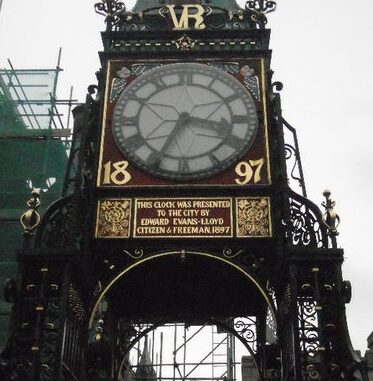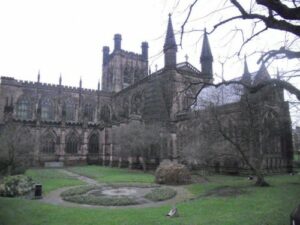
The beautiful city of Roman and Medieval Chester was founded by the Romans way back in 79AD, and since then, it has become a popular tourist and shopping destination, while still remaining as one of the most well-kept historic cities in the UK.
The city boasts a number of historic attractions, the most popular being the Roman Amphitheatre, Chester Cathedral, the City Walls, the Roman Gardens, and Chester Castle.
The Amphitheatre dates from around the time that the city of Chester itself was founded in the late AD 70’s, and was initially built for military training and drills, but it was also used for bull fighting, boxing and wrestling. By 350AD, the structure was no longer used, and the pit was only rediscovered in 1929 during construction work. It 2007, the site was taken over by English Heritage, and in 2010, a mural was commissioned, that would help visitors to envisage what the complete amphitheatre would have looked like.
The Roman Gardens stretch along to the river, and are situated just outside the city walls, next to the Roman Amphitheatre. The gardens have been used for sports, entertainment, trade and defence since the Roman times, including cock-pit fighting tobacco pipe manufacture. In December 2011, three commissioned ‘Four Seasons’ mosaics were unveiled at the gardens to commemorate the Chester Civic Trust’s Golden Jubilee.
Chester’s City Wall is the most complete circuit of a defensive town wall in Britain. For 2000 years, the walls have evolved, and in the 18th century, the walls became a fashionable promenade. Once the walls had outlived their military uses they were converted into an elaborate walkway around the city. These days, the City Wall is a Scheduled Ancient Monument, owned by Chester City Council. A walk around the complete circuit takes around an hour, giving a vivid reminder of what a medieval fortified town was like.
The popular and historic tourist attraction, Chester Castle, was built in 1070 by Hugh Lupus, the First Earl of Chester. The remains of the castle stand on a bend of the River Dee, which runs all the way through Chester, just a few miles away from the Welsh borders.
Chester Cathedral is a beautiful splendour within itself. Originally a monastery, and with a history spanning over 2000 years, the Cathedral contains the finest woodwork quire in the country, a picture of the Virgin Mary and Jesus as an infant, that was painted on the web of a caterpillar, the Chester Imp, an original clergy Consistory Court, and Refrectory Creation Window which was installed in 2001, and which it illustrates the account of Creation in the book of Genesis. As well as this, the Cathedral hosts special church services, events and choir performances throughout the year, and it also has a café and a gift shop. It is definitely not a site to be missed!
Along with these major attractions, there are also some secret treasures that Chester has to offer. The Chester Rows are continuous half-timbered galleries, reached by steps, which form a second row of shops above those at street level along the high streets of the City Centre. Some of the rows are originals, and some are Victorian copies, which contribute to the unique individuality of the city. The Rows are the only ones of their kind in the world.
The famous Eastgate Clock is also a unique and stunning landmark that can be seen on the bridge from most points of the city centre. The clock was created to commemorate Queen Victoria’s Diamond Jubilee and it offers spectacular views of Chester and the neighbouring Welsh hills.
The Parish Church of Saint John the Baptist, Chester, is a must-see for its architecture and stained glass windows alone, as well as the outside ruins. It is one of the finest examples in Europe of the transition from Romanesque to the Gothic architecture. St John’s became the Cathedral of West Mercia in 1075AD, and continued to be an Episcopal Church for many years afterwards. Inside, the church is small and beautifully quaint, and the organ is the same one that was used in Westminster Abbey for the Coronation of Queen Victoria in 1838.
As well as historic attractions, there are also plenty of eating places, ranging from fast food to fine dining, but if you want to keep in with the historic theme, head to The Old Custom House Inn in Watergate Street, which was built in the 17th century, and which still has its original stone and wood-work. Offering a scrumptious selection of quick bites, drinks, and main meals, you can even enjoy your food in the building’s old wine-cellar!
Chester is also full of a diverse array of bars, high-street stores and hotels, and you should be able to find a quirky or tasty souvenir to take back with you from one of the few antique or sweet shops which are dotted about.
For more information about the city, please visit: www.visitchester.com


Leave a Reply